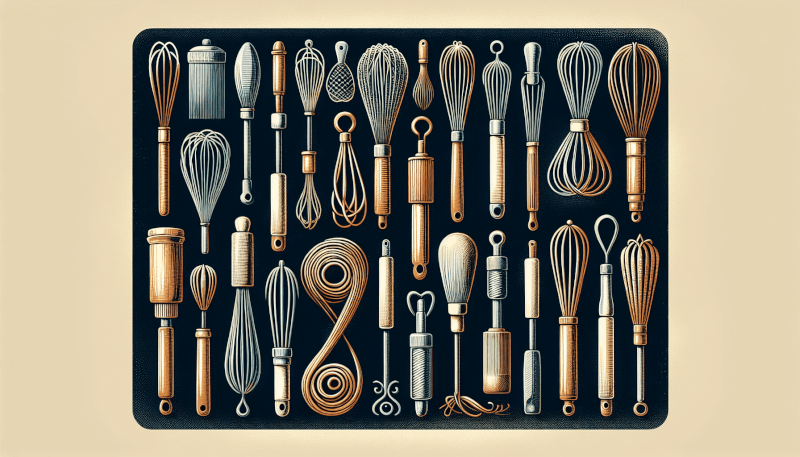Today we’re going to take a closer look at the world of home baking whisks. Whether you’re an experienced baker or just starting out, understanding the different types of whisks can make a big difference in your baking endeavors. From balloon whisks to flat whisks, each type has its own unique purpose and benefits. So, grab your apron and let’s explore the wonderful world of home baking whisks together!
Balloon Whisk
Description
A balloon whisk, also known as a wire whisk, is a versatile tool used in baking. It consists of a handle and several looped wires that form a balloon shape at the end. The wires are flexible, allowing them to easily blend and incorporate ingredients together.
Uses
The balloon whisk is commonly used for whisking, beating, and incorporating air into ingredients. It is ideal for whipping cream, beating eggs, mixing batters, and creating fluffy meringues. Its design enables it to efficiently incorporate air and create volume in various recipes.
Pros
One of the main advantages of the balloon whisk is its ability to quickly and effectively combine ingredients. The wires allow for a thorough mixing and incorporate air to create light and fluffy textures. Additionally, the balloon whisk’s versatility makes it a staple tool in any baker’s arsenal.
Cons
Although the balloon whisk is generally reliable, it may not be suitable for mixing denser doughs or heavy batters. Its lightweight design may not provide the necessary strength and stability to handle tougher ingredients. In such cases, alternative whisk options can be more suitable.
French Whisk
Description
The French whisk, also known as a piano whisk, features a unique design with longer, narrower wires compared to the balloon whisk. It has a slender handle and a cylindrical shape, making it distinct from other whisk types.
Uses
The French whisk excels at making emulsions, such as vinaigrettes and mayonnaise. Its narrow wires allow for a more focused whisking action, ensuring thorough blending of ingredients. Additionally, it is suitable for delicate tasks such as mixing custards, sauces, and gravies.
Pros
The French whisk’s slender wires make it ideal for tasks that require precision and finesse. It is excellent at emulsifying and creating smooth, creamy textures. The design also allows for easy access into corners and edges of bowls or pans.
Cons
While the French whisk is adept at certain tasks, it may not be as effective when it comes to incorporating air into mixtures or creating volume. Its narrow shape limits the amount of air it can whisk into the ingredients, making it less suitable for certain recipes that require aeration.

Flat Whisk
Description
The flat whisk, also known as a roux whisk, has a distinctive flat shape with wide, flat wires. It is designed to evenly distribute heat and prevent clumping when working with ingredients on the stovetop.
Uses
The flat whisk is primarily used for making roux, a cooked mixture of fat and flour used as a thickening agent in sauces, gravies, and soups. Its shape and flexible wires help break down lumps and create a silky smooth consistency. It can also be used for stirring ingredients when making custards or stovetop puddings.
Pros
The flat whisk’s flat shape and wide wires make it incredibly efficient at breaking down lumps and evenly blending ingredients. It ensures smooth and lump-free sauces and gravies, enhancing the overall texture and appearance of the dish.
Cons
The flat whisk’s specific design and purpose limit its versatility. While it excels at making roux and stirring on the stovetop, it may not be as effective in other baking tasks that require incorporating air or mixing lighter batters.
Dough Whisk
Description
A dough whisk, sometimes called a Danish whisk, is a sturdy tool specifically designed for mixing doughs. It features a unique twisted loop design with thick wires that converge into a handle.
Uses
The dough whisk is perfect for mixing heavy doughs, such as bread or pizza dough. Its sturdy construction allows it to handle dense mixtures without getting tangled or clogged. It ensures thorough blending and prevents over-mixing, resulting in well-developed gluten structures.
Pros
The dough whisk’s twisted loop design effortlessly cuts through thick doughs, minimizing the need for excessive hand kneading. Its sturdy construction makes it durable and long-lasting, able to withstand the demands of heavy dough mixing.
Cons
While the dough whisk is excellent for mixing dense doughs, it may not be as efficient or effective when it comes to lighter batters or whisking delicate ingredients. Its specific purpose and design limit its versatility in other baking tasks.

Spiral Whisk
Description
The spiral whisk, also known as a coil whisk, is a unique type of whisk that features a spiral-shaped wire end attached to a handle. It stands out with its eye-catching design and ability to quickly blend ingredients.
Uses
The spiral whisk is great for tasks that require a quick mix or light blending. It excels at quickly incorporating dry ingredients into liquids, such as mixing cocoa powder into milk for hot chocolate or blending dry spices into sauces. Additionally, its shape enables it to reach into corners and edges of containers easily.
Pros
The spiral whisk’s distinctive shape allows for efficient blending and quick mixing. Its spiral end makes the blending process smooth and effortless, reducing the risk of lumps. Furthermore, it is easy to clean and store due to its compact design.
Cons
While the spiral whisk is efficient at quick blending tasks, it may not be the best option for whisking air into ingredients or creating volume in recipes. Its design and shape limit its suitability for certain baking tasks that require aeration or more thorough mixing.
Silicone Whisk
Description
A silicone whisk is a modern twist on the traditional wire whisk. It features a handle and wires coated in silicone, giving it heat-resistant and non-stick properties. The silicone coating makes it suitable for use in non-stick pans and heat-sensitive recipes.
Uses
The silicone whisk is ideal for tasks that require gentle mixing or stirring in delicate cookware. Its heat resistance allows it to be used in high-temperature settings without scratching or damaging non-stick surfaces. It can be used for various recipes, ranging from sauces and custards to scrambled eggs.
Pros
The silicone whisk’s non-stick properties make it a safe and reliable option for use with non-stick cookware. It prevents scratching and ensures easy release of ingredients. Additionally, its heat resistance provides versatility in cooking methods.
Cons
While the silicone whisk is suitable for many tasks, it may not be as effective at whisking and incorporating air into ingredients compared to traditional wire whisks. Its flexibility and silicone coating may hinder the whisking action required for certain recipes.

Ball Whisk
Description
The ball whisk, also known as an egg whisk or 8-wire whisk, is characterized by its rounded shape at the end. It consists of several wires that loop into a ball shape, providing increased coverage when whisking.
Uses
The ball whisk is perfect for beating eggs, whipping cream, and creating light and airy batters. Its rounded shape allows the wires to reach more surface area, ensuring thorough blending. Additionally, it is well-suited for tasks that require gentle folding, such as incorporating dry ingredients into wet mixtures.
Pros
The ball whisk’s unique shape and design enable it to cover a larger area during whisking, resulting in quicker and more efficient mixing. It is excellent at incorporating air into recipes, creating light and fluffy textures. Its versatility makes it a handy tool in any baking or cooking endeavor.
Cons
While the ball whisk excels in many tasks, it may not be as effective for heavier mixtures or denser doughs. Its light and flexible wires are more suitable for lighter batters and delicate folding rather than heavy-duty mixing.
Wire Whisk
Description
The wire whisk, also commonly referred to as a traditional whisk or standard whisk, is the most recognized type of whisk. It features thin wires that form a balloon shape, similar to the balloon whisk.
Uses
The wire whisk is a versatile tool used for whisking, stirring, and blending ingredients. It is suitable for a wide range of recipes, including beating eggs, mixing batters, whisking sauces, and creating whipped cream. Its flexible wires ensure thorough blending and efficient aeration.
Pros
The wire whisk’s classic design has withstood the test of time, proving to be effective in various tasks. It is known for its ability to whisk air into ingredients, creating light and fluffy mixtures. It is also easy to use and clean, making it a go-to whisk for everyday baking needs.
Cons
While the wire whisk is a reliable choice for most baking tasks, it may not be suitable for heavier mixtures or particularly stiff doughs. Its lightweight design and flexibility can limit its effectiveness in handling tough ingredients, requiring alternative whisk options for those specific recipes.

Flat Coil Whisk
Description
The flat coil whisk is a hybrid between the traditional wire whisk and the flat whisk. It features a flat base with thin wires coiled into a compact shape. It combines the benefits of both designs to offer a unique whisking experience.
Uses
The flat coil whisk is versatile and suitable for a variety of tasks. It is excellent for blending thick sauces and batters, breaking up lumps, and ensuring even distribution of ingredients. It can be used for both stovetop and baking tasks, making it a valuable tool in the kitchen.
Pros
The flat coil whisk’s combination of a flat base and coiled wires provides excellent maneuverability and coverage. It ensures thorough mixing, incorporating air efficiently, and breaking down any lumps. Its versatility makes it a valuable addition to any cookware collection.
Cons
While the flat coil whisk offers the benefits of both its parent designs, it may not excel in tasks that require specialized whisking actions. For instance, it may not be as efficient as the flat whisk for creating roux, or as adept as the wire whisk at whisking air into recipes. Depending on the specific task, alternative whisk styles may be more suitable.
Rotary Whisk
Description
The rotary whisk, also known as a rotary egg beater or hand-crank whisk, is a manual whisking tool powered by hand rotation. It consists of a handle attached to a gear mechanism that turns the beaters or blades.
Uses
The rotary whisk is commonly used for whisking eggs, creating emulsions, and blending various mixtures by hand. Its manual operation offers precise control and allows for gentle or vigorous whisking. It is especially useful when access to a power source is limited or when a more traditional whisking method is desired.
Pros
The rotary whisk’s manual operation allows for greater control over whisking speed and intensity. It is particularly useful when gentle or controlled whisking is required. Additionally, its portable nature makes it convenient for outdoor cooking or situations where electronic appliances are unavailable.
Cons
While the rotary whisk offers control and flexibility, it may require more effort and time compared to electric or battery-powered options. It may not be suitable for whisking large quantities or heavy-duty mixing, as extensive hand rotation can be tiring. For quick and efficient whisking, electric or battery-powered whisks may be more suitable.
Understanding the different types of home baking whisks allows you to choose the most suitable tool for your culinary adventures. Whether you’re whipping cream, mixing batter, or creating delicate sauces, having the right whisk can make a significant difference in your culinary results. Consider the specific uses, pros, and cons of each whisk type to find the perfect addition to your kitchen utensil collection. Happy whisking!



